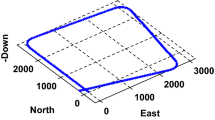Abstract
In this work, we systematically analyze how good ground truth (GT) datasets for evaluating methods based on Time-of-Flight (ToF) imaging data should look like. Starting from a high level characterization of the application domains and requirements they typically have, we characterize how good datasets should look like and discuss how algorithms can be evaluated using them. Furthermore, we discuss the two different ways of obtaining ground truth data: By measurement and by simulation.
Access this chapter
Tax calculation will be finalised at checkout
Purchases are for personal use only
Preview
Unable to display preview. Download preview PDF.
Similar content being viewed by others
References
Boehler, W., Vicent, M.B., Marbs, A.: Investigating laser scanner accuracy. The International Archives of Photogrammetry, Remote Sensing and Spatial Information Sciences 34(Part 5), 696–701 (2003)
Geiger, A., Lenz, P., Urtasun, R.: Are we ready for autonomous driving? the kitti vision benchmark suite. In: Computer Vision and Pattern Recognition (CVPR), Providence, USA (June 2012)
Reynolds, M., Doboš, J., Peel, L., Weyrich, T., Brostow, G.J.: Capturing time-of-flight data with confidence. In: CVPR (2011)
Clark, J., Robson, S.: Accuracy of measurements made with a cyrax 2500 laser scanner against surfaces of known colour. Survey Review 37(294), 626–638 (2004)
Soudarissanane, S., Lindenbergh, R., Menenti, M., Teunissen, P.: Incidence angle influence on the quality of terrestrial laser scanning points. In: ISPRS Workshop Laserscanning (2009)
Lichti, D.D.: Error modelling, calibration and analysis of an am–cw terrestrial laser scanner system. ISPRS Journal of Photogrammetry and Remote Sensing 61(5), 307–324 (2007)
Newcombe, R.A., Izadi, S., Hilliges, O., Molyneaux, D., Kim, D., Davison, A.J., Kohli, P., Shotton, J., Hodges, S., Fitzgibbon, A.: KinectFusion: Real-time dense surface mapping and tracking. In: 2011 10th IEEE International Symposium on Mixed and Augmented Reality, vol. 7, pp. 127–136 (2011)
Izadi, S., Newcombe, R.A., Kim, D., Hilliges, O., Molyneaux, D., Hodges, S., Kohli, P., Shotton, J., Davison, A.J., Fitzgibbon, A.: KinectFusion: Real-time dynamic 3D surface reconstruction and interaction. In: ACM SIGGRAPH 2011 Talks, p. 23. ACM (2011)
Khoshelham, K.: Accuracy analysis of kinect depth data. In: ISPRS Workshop Laser Scanning, vol. 38, p. 1 (2011)
Meister, S., Izadi, S., Kohli, P., Hämmerle, M., Rother, C., Kondermann, D.: When can we use kinectfusion for ground truth acquisition? In: 2012 IEEE/RSJ International Conference on Intelligent Robots and Systems (IROS), Workshops & Tutorials (2012)
Besl, P.J., McKay, N.D.: Method for registration of 3-d shapes. In: Robotics-DL Tentative, International Society for Optics and Photonics, pp. 586–606 (1992)
Bradski, G.: The OpenCV Library. Dr. Dobb’s Journal of Software Tools (2000)
Maier-Hein, L., Schmidt, M., Franz, A.M., dos Santos, T.R., Seitel, A., Jähne, B., Fitzpatrick, J.M., Meinzer, H.P.: Accounting for anisotropic noise in fine registration of time-of-flight range data with high-resolution surface data. In: Jiang, T., Navab, N., Pluim, J.P.W., Viergever, M.A. (eds.) MICCAI 2010, Part I. LNCS, vol. 6361, pp. 251–258. Springer, Heidelberg (2010)
Schmidt, M.: Analysis, Modeling and Dynamic Optimization of 3D Time-of-Flight Imaging Systems. PhD thesis, University of Heidelberg (20011)
Meister, S., Kondermann, D.: Real versus realistically rendered scenes for optical flow evaluation. In: Proceedings of 14th ITG Conference on Electronic Media Technology (2011)
Keller, M., Kolb, A.: Real-time simulation of time-of-flight sensors. J. Simulation Practice and Theory 17, 967–978 (2009)
Research, L.: Optics software for layout and optimization (oslo), http://www.lambdares.com
Zemax, R.: Zemax, optical design software, http://www.radiantzemax.com
Schmidt, M., Jähne, B.: A physical model of time-of-flight 3D imaging systems, including suppression of ambient light. In: Kolb, A., Koch, R. (eds.) Dyn3D 2009. LNCS, vol. 5742, pp. 1–15. Springer, Heidelberg (2009)
Schmidt, M.: Analysis, Modeling and Dynamic Optimization of 3D Time-of-Flight Imaging Systems. PhD thesis, University of Heidelberg (2011)
Geiger, A., Lenz, P., Urtasun, R.: Are we ready for autonomous driving? the kitti vision benchmark suite. In: Conference on Computer Vision and Pattern Recognition (CVPR) (2012)
Dal Mutto, C., Zanuttigh, P., Mattoccia, S., Cortelazzo, G.: Locally consistent toF and stereo data fusion. In: Fusiello, A., Murino, V., Cucchiara, R. (eds.) ECCV 2012 Ws/Demos, Part I. LNCS, vol. 7583, pp. 598–607. Springer, Heidelberg (2012)
Zhang, L., Curless, B., Seitz, S.M.: Spacetime stereo: Shape recovery for dynamic scenes. In: Proceedings of the 2003 IEEE Computer Society Conference on Computer Vision and Pattern Recognition, vol. 2, pp. II–367. IEEE (2003)
Haeusler, R., Nair, R., Kondermann, D.: (Ensemble learning for confidence measures in stereo vision)
Author information
Authors and Affiliations
Editor information
Editors and Affiliations
Rights and permissions
Copyright information
© 2013 Springer-Verlag Berlin Heidelberg
About this chapter
Cite this chapter
Nair, R. et al. (2013). Ground Truth for Evaluating Time of Flight Imaging. In: Grzegorzek, M., Theobalt, C., Koch, R., Kolb, A. (eds) Time-of-Flight and Depth Imaging. Sensors, Algorithms, and Applications. Lecture Notes in Computer Science, vol 8200. Springer, Berlin, Heidelberg. https://doi.org/10.1007/978-3-642-44964-2_4
Download citation
DOI: https://doi.org/10.1007/978-3-642-44964-2_4
Publisher Name: Springer, Berlin, Heidelberg
Print ISBN: 978-3-642-44963-5
Online ISBN: 978-3-642-44964-2
eBook Packages: Computer ScienceComputer Science (R0)




